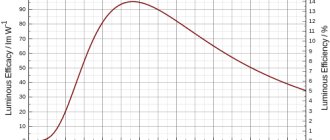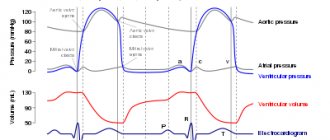Electromagnetic wave scale
The electromagnetic wave or radiation scale is a series of ranges of electromagnetic waves that are distributed according to frequency. Periodically changing vortex electric and magnetic fields propagating in space are electromagnetic oscillations.
General concept
The properties of electromagnetic oscillations were discovered at the beginning of the 19th century by the English scientist D. C. Maxwell. The physicist believed that electromagnetic waves are perpendicular to the direction of propagation of the wave, its speed. But the electromagnetic field exists separately from the above two. The magnetic and electric fields, interacting with each other, act on the charged particles of the surface of the wave front, creating a field that exists independently and has its own properties.
Electromagnetic waves can propagate in different media, including in a vacuum. The field itself is matter that spreads in the environment. The speed of propagation of an electromagnetic wave in a vacuum is equal to the speed of light, i.e. 3*10 to the 8th power m/s. The meaning does not decay as it passes through space, constantly.
The scale of electromagnetic radiation shows how one qualitative type of radiation transforms into another as the interrelated quantitative indicators of frequency and wavelength change. One type of radiation range is visible light.
Links[edit]
- V. N. Dunaev “Electromagnetic radiation and the risk to public health when using cellular communications” // Hygiene and Sanitation, No. 6, 2007, p. 56-57
- Remote control of magnetic fields with frequencies of 50 Hz. Kharkov, 1986, SN-3206-85.2
- Guidelines for hygienic assessment of the main parameters of fields with a frequency of 50 Hz. Kharkov, 1986. SN 3207-85
- Yu. G. Grigoriev //Hygiene and Sanitation, No. 3, 2003, p. 14-16
- V. N. Dunaev “Electromagnetic radiation and the risk to public health when using cellular communications” // Hygiene and Sanitation, No. 6, 2007, p. 56-57
Additional colors of the spectrum
The visible light spectrum contains both primary and secondary colors. How can I get additional colors? Their production is based on the experience of I. Newton, who in 1671, using a prism, decomposed a white beam of sunlight into a spectrum: successively red, orange, yellow, green, blue and violet colors.
Additional colors of the spectrum are obtained in different ways:
Additional colors of the spectrum
- If you divide the spectrum into two parts (red-orange-yellow and green-blue-violet), two mixtures of the first three and the second three will give two colors. The peculiarity of the latter is such that if you put them together with a lens, you get white again.
- If you physically close one color in the spectrum, then collect the remaining colors with a lens, the resulting color will be complementary to the closed one. For example, if you close green, red will gather, closing yellow will create purple. Red will be complementary to green, and purple will be complementary to yellow.
By closing the sequence of colors of the spectrum into a circle, we obtain a diagram called the spectral circle.
Primary additional colors:
- red and green;
- yellow and purple;
- blue and orange.
Table 1. Additional colors.
| Highlighted part | Red | Orange | Yellow | Yellow-green | Green | bluish green |
| Color of the mixture of the remaining rays | Bluish green | Blue | Blue | Violet | Purple | Red |
When mixing additional colors, which has been proven experimentally, it is no longer possible to obtain a pure color - any admixture of an additional color to the main color reduces the saturation.
X-ray and gamma radiation
In the field of X-ray and gamma radiation, the quantum properties of radiation come to the fore.
X-ray radiation occurs when fast charged particles (electrons, protons, etc.) decelerate, as well as as a result of processes occurring inside the electronic shells of atoms.
Gamma radiation is a consequence of phenomena occurring inside atomic nuclei, as well as as a result of nuclear reactions. The boundary between X-ray and gamma radiation is determined conventionally by the value of the energy quantum corresponding to a given frequency of radiation.
X-ray radiation consists of electromagnetic waves with a length from 50 nm to 10-3 nm, which corresponds to a quantum energy from 20 eV to 1 MeV.
Gamma radiation consists of electromagnetic waves with a wavelength less than 10-2 nm, which corresponds to a quantum energy greater than 0.1 MeV.
Solar radiation spectrum
The sun is the source of life on the planet, a source of radiation, sunlight that carries energy.
Solar radiation spectrum
The electromagnetic spectrum of sunlight includes three different types of waves:
- ultraviolet radiation;
- visible light;
- infrared radiation.
The first sequential type has the lowest frequencies and a relatively long wavelength, the last one has the highest frequencies and a short wavelength.
Content
- 1 Characteristics of electromagnetic radiation
- 2 Ranges of electromagnetic radiation 2.1 Radio waves 2.1.1 Microwave radiation
- 5.1 Effect on living beings 5.1.1 Optical range
Visible part of the spectrum
D. K. Maxwell concluded that visible light is a type of electromagnetic radiation; the spectrum of visible sunlight consists of seven colors. A person can see how, when refracted in a prism, light breaks up into seven colors, and can admire the light refracted in raindrops, looking at a rainbow.
Colors are distributed on the scale in accordance with frequency and occupy a small segment on the scale, fit into a relatively small range, but this is all that can be seen with the eyes. Infrared and ultraviolet radiation, with smaller and larger values, are no longer accessible to human vision.
Rainbow
In a rainbow, one color gradually changes into another according to a specific sequence that represents the distribution of colors when a beam of white visible light is split. The properties of color (red, blue, yellow) are determined by the properties of the corresponding wavelengths.
The visible part of the solar spectrum is the part of the spectrum that, when exposed to the organ of vision, causes visual sensations. The yellow-green ray produces the strongest responses in the human eye; the rest are less sensitive. The rays visible to the eye have a wavelength in the range of 400–760 nm. Some longer and shorter wavelength rays are available to the eye if they are of sufficient intensity.
Light is important for humans. By irritating the organ of vision, light activates metabolism, improves well-being, inspires, and helps improve performance. It can be noted that insufficient lighting leads to a decrease in activity, in enterprises it leads to errors and work-related injuries.
Impact of electromagnetic rays on humans
The nervous system is extremely sensitive to the influence of electromagnetic rays: nerve cells reduce their conductivity. As a result, memory deteriorates and the sense of coordination is dulled.
When a person is exposed to EMR, the immune system is not only suppressed - it begins to attack the body.
IMPORTANT! For pregnant women, electromagnetic radiation poses a particular danger: the rate of fetal development decreases, defects appear in the formation of organs, and there is a high probability of premature birth.
Electromagnetic radiation scale
Differing from each other quantitatively, electromagnetic waves can be obtained in a certain way using instruments. There are natural and artificial sources of the phenomenon. In addition to instruments and wave sources on Earth, electromagnetic waves are also emitted by space objects.
Low-frequency waves, radio waves, infrared light radiation, optical radiation, X-ray spectra, invisible gamma radiation - various sections of a conventional scale showing λ regions - wavelength regions.
Electromagnetic radiation spectrum table
| Name | Wavelength | Frequency | Sources, | Cosmic sources |
| Low frequency emissions | more than 10000m | 0-30 kHz | Alternating current generator, home and office electrical equipment, power lines, etc. | Earth's magnetic field |
| Radio waves | 1mm-10000m | 30kHz-300GHz | Alternating current in an oscillating circuit, semiconductor devices | The Sun, planets and small bodies of the Solar System, clouds of interstellar gas, cosmic microwave background radiation at the early stage of the expansion of the Universe, quasars |
| Infrared light radiation | 1mm-780nm | 300GHz-429THz | Heat sources, laser, mercury-quartz lamp | The Sun, interstellar and circumstellar dust, cosmic microwave background radiation at the early stage of expansion of the Universe, planets, small bodies of the Solar system |
| Visible light radiation | 780-380nm | 429-750THz | Incandescent lamp, flame, lightning, laser | Sun, other stars (with a temperature of 10-100 thousand degrees) |
| Ultraviolet radiation | 380-10nm | 7.5*1000000000000000-3*1000000000000000000Hz | Carbon arc | Sun, hot stars, high temperature plasma |
| X-ray radiation | 10-5*10v-3 degrees nm | 3*100000000000000000-6*1000000000000000000000Hz | X-ray tube | The Sun, neutron stars and possibly black holes, globular star clusters, to extragalactic sources - quasars, distant galaxies and their clusters. |
| Gamma radiation | less than 5*10 to the 3rd power nm | more than 6*1000000000000000000000 Hz | Atomic nuclei, Cobalt-60 | Sun, cosmic background radiation, some pulsars (neutron stars), supernovae, Milky Way, galactic center regions, many galaxies and quasars |
Sensitivity of the human eye One of the main properties of electromagnetic waves is the degree of their absorption by matter. The difference can be found between long-wave and short-wave radiation. The former are absorbed with much greater intensity than short-wavelength ones, but they have an additional property: when absorbed, they exhibit the properties of particles.
Spectral sensitivity of the eye
By converting the energy coming from a source of visible light in the visual system, a person receives signals from the environment. Light hits the retina of the eye, excites photoreceptors, from which the signal is transmitted to the neural connections of the cerebral cortex, located in the occipital lobe of the cerebral cortex. As a result of such transformations, a visual image is formed in the brain.
Developing evolutionarily, the human eye was formed in the best way to perceive sunlight. As a result, the visual organ of a modern person detects electromagnetic radiation in the wavelength range of 400–750 nm (visible radiation). The eye is protected from lower wavelength radiation (ultraviolet) by an area of the lens with low transparency.
Biological effects of radio wave radiation
The terrible sacrificial experience of using powerful radio wave radiation in radar technology showed the specific effect of radio waves depending on the wavelength (frequency).
The destructive effect on the human body is not so much the average as the peak radiation power, at which irreversible phenomena occur in protein structures. For example, the power of continuous radiation from the magnetron of a microwave oven (microwave), amounting to 1 kW, affects only food in a small closed (shielded) volume of the oven, and is almost safe for a person nearby. The power of a radar station (radar) of 1 kW of average power emitted by short pulses with a duty cycle of 1000:1 (the ratio of the repetition period to the pulse duration) and, accordingly, a pulse power of 1 MW, is very dangerous for human health and life at a distance of up to hundreds meters from the emitter. In the latter, of course, the direction of the radar radiation also plays a role, which emphasizes the destructive effect of pulsed rather than average power.
Exposure to meter waves
High-intensity meter waves emitted by pulse generators of meter radar stations (radars) with a pulse power of more than a megawatt (such as the P-16 early warning station) and commensurate with the length of the spinal cord of humans and animals, as well as the length of axons, disrupt conductivity these structures, causing diencephalic syndrome (HF disease). The latter leads to the rapid development (over a period of several months to several years) of complete or partial (depending on the received pulse dose of radiation) irreversible paralysis of a person’s limbs, as well as disruption of the innervation of the intestines and other internal organs.
Impact of decimeter waves
Decimeter waves are comparable in wavelength to blood vessels, covering such human and animal organs as the lungs, liver and kidneys. This is one of the reasons why they cause the development of “benign” tumors (cysts) in these organs. Developing on the surface of blood vessels, these tumors lead to the cessation of normal blood circulation and disruption of organ function. If such tumors are not surgically removed in time, the death of the body occurs. Decimeter waves of dangerous intensity levels are emitted by the magnetrons of such radars as the P-15 mobile air defense radar, as well as the radar of some aircraft.
Exposure to centimeter waves
Powerful centimeter waves cause diseases such as leukemia - “white blood”, as well as other forms of malignant tumors in humans and animals. Waves of intensity sufficient for the occurrence of these diseases are generated by the centimeter range radars P-35, P-37 and almost all aircraft radars.










